Research on Classification Maintenance Strategy for More Electric Aircraft Actuation Systems Based on Importance Measure
Abstract
1. Introduction
2. Research on Maintenance Strategies
2.1. Classification of Maintenance for Actuation System Components
2.2. Importance-Based Ranking Method
2.3. Maintenance and Replacement Costs
3. Maintenance Algorithm and Reliability Model
3.1. Genetic Algorithm with Enhanced Local Search Capability
3.2. Actuation System Reliability Model
4. Actuation System Maintenance Simulation Analysis
5. Conclusions and Future Works
Author Contributions
Funding
Data Availability Statement
Conflicts of Interest
References
- Patnaik, B.; Kumar, S.; Gawre, S. Recent advances in converters and storage technologies for more electric aircrafts: A review. IEEE J. Miniaturiz. Air Space Syst. 2022, 3, 78–87. [Google Scholar] [CrossRef]
- Cano, T.C.; Castro, I.; Rodríguez, A.; Lamar, D.G.; Khalil, Y.F.; Albiol-Tendillo, L.; Kshirsagar, P. Future of electrical aircraft energy power systems: An architecture review. IEEE Trans. Transp. Electrif. 2021, 7, 1915–1929. [Google Scholar] [CrossRef]
- Fard, M.T.; He, J.; Huang, H.; Cao, Y. Aircraft distributed electric propulsion technologies—A review. IEEE Trans. Transp. Electrif. 2022, 8, 4067–4090. [Google Scholar] [CrossRef]
- Sayed, E.; Abdalmagid, M.; Pietrini, G.; Sa’adeh, N.M.; Callegaro, A.D.; Goldstein, C.; Emadi, A. Review of electric machines in more-/hybrid-/turbo-electric aircraft. IEEE Trans. Transp. Electrif. 2021, 7, 2976–3005. [Google Scholar] [CrossRef]
- Sarlioglu, B.; Morris, C.T. More electric aircraft: Review, challenges, and opportunities for commercial transport aircraft. IEEE Trans. Transp. Electrif. 2015, 1, 54–64. [Google Scholar] [CrossRef]
- Iyaghigba, S.D.; Ali, F.; Jennions, I.K. A Review of Diagnostic Methods for Hydraulically Powered Flight Control Actuation Systems. Machines 2023, 11, 165. [Google Scholar] [CrossRef]
- Yin, Z.; Hu, N.; Chen, J.; Yang, Y.; Shen, G. A review of fault diagnosis, prognosis and health management for aircraft electromechanical actuators. IET Electr. Power Appl. 2022, 16, 1249–1272. [Google Scholar] [CrossRef]
- Berri, P.C.; Dalla, M.D.; Mainini, L. Computational framework for real-time diagnostics and prognostics of aircraft actuation systems. Comput. Ind. 2021, 132, 103523. [Google Scholar] [CrossRef]
- Jia-Qi, L.; Yun-Wen, F.; Da, T.; Jun-Yu, C.; Cheng, L. Operational reliability evaluation and analysis framework of civil aircraft complex system based on intelligent extremum machine learning model. Reliab. Eng. Syst. Saf. 2023, 235, 109218. [Google Scholar] [CrossRef]
- Wang, S.; Shi, J.; Qiao, Y. Comprehensive Reliability of Aircraft Actuation System. In Advances in Reliability and Maintainability Methods and Engineering Applications: Essays in Honor of Professor Hong-Zhong Huang on His 60th Birthday; Springer Nature: Cham, Switzerland, 2023; pp. 211–237. [Google Scholar]
- Yu, M.; Meng, J.; Zhu, R.; Jiang, W.; Shen, Q. Sensor fault diagnosis for uncertain dissimilar redundant actuation system of more electric aircraft via bond graph and improved principal component analysis. Meas. Sci. Technol. 2022, 34, 015120. [Google Scholar] [CrossRef]
- Birnbaum, Z.W. On the Importance of Different Components in a Multicomponent System; Academic Press: New York, NY, USA, 1968; Volume 24. [Google Scholar]
- Kuo, W.; Zhu, X. Some recent advances on importance measures in reliability. IEEE Trans. Reliab. 2012, 61, 344–360. [Google Scholar] [CrossRef]
- Aven, T.; Nøkland, T.E. On the use of uncertainty importance measures in reliability and risk analysis. Reliab. Eng. Syst. Saf. 2010, 95, 127–133. [Google Scholar] [CrossRef]
- Liu, M.; Wang, D.; Zhao, J.; Si, S. Importance measure construction and solving algorithm oriented to the cost-constrained reliability optimization model. Reliab. Eng. Syst. Saf. 2022, 222, 108406. [Google Scholar] [CrossRef]
- Vu, H.C.; Do, P.; Barros, A. A stationary grouping maintenance strategy using mean residual life and the birnbaum importance measure for complex structures. IEEE Trans. Reliab. 2015, 65, 217–234. [Google Scholar] [CrossRef]
- Huseby, A.B.; Kalinowska, M.; Abrahamsen, T. Birnbaum criticality and importance measures for multistate systems with repairable components. Probab. Eng. Informational Sci. 2022, 36, 66–86. [Google Scholar] [CrossRef]
- Fu, Y.; Yuan, T.; Zhu, X. Importance-measure based methods for component reassignment problem of degrading components. Reliab. Eng. Syst. Saf. 2019, 190, 106501. [Google Scholar] [CrossRef]
- Liu, M.; Wang, D.; Si, S. Solving algorithm design for the cost minimization reliability optimization model driven by a novel cost-based importance measure. Reliab. Eng. Syst. Saf. 2024, 244, 109907. [Google Scholar] [CrossRef]
- Ma, C.; Wang, W.; Cai, Z.; Zhao, J. Maintenance optimization of reconfigurable systems based on multi-objective Birnbaum importance. Proc. Inst. Mech. Eng. Part O J. Risk Reliab. 2022, 236, 277–289. [Google Scholar] [CrossRef]
- Qiu, S.; Ming, X.; Sallak, M.; Lu, J. A Birnbaum importance-based two-stage approach for two-type component assignment problems. Reliab. Eng. Syst. Saf. 2022, 218, 108051. [Google Scholar] [CrossRef]
- Zhao, J.; Zhang, Z.; Liang, M.; Cao, X. Weakness Analysis of Multi-state Hybrid Systems Based on Integrated Importance Measure. In Proceedings of the IEEE International Conference on Industrial Engineering and Engineering Management, Singapore, 18–21 December 2023; pp. 1351–1355. [Google Scholar]
- Wu, S.; Coolen, F. Importance measures in reliability engineering: An introductory overview. In The Palgrave Handbook of Operations Research; Palgrave Macmillan: Cham, Switzerland, 2022; pp. 659–674. [Google Scholar]
- Dui, H.; Liu, M.; Song, J.; Wu, S. Importance measure-based resilience management: Review, methodology and perspectives on maintenance. Reliab. Eng. Syst. Saf. 2023, 237, 109383. [Google Scholar] [CrossRef]
- Wang, C.; Fan, I.S.; King, S. Failures mapping for aircraft electrical actuation system health management. In Proceedings of the 7th European Conference on the Prognostics and Health Management Society, Turin, Italy, 6–8 July 2022; Volume 7, pp. 509–520. [Google Scholar]
- Zhang, Y.; Zhang, C.; Wang, S.; Chen, R.; Tomovic, M.M. Performance Degradation Based on Importance Change and Application in Dissimilar Redundancy Actuation System. Mathematics 2022, 10, 843. [Google Scholar] [CrossRef]
- Kuo, W. Optimal Reliability Design: Fundamentals and Applications; Cambridge University Press: Cambridge, UK, 2001. [Google Scholar]
- Xie, W.; Liao, H.; Zhu, X. Estimation of gross profit for a new durable product considering warranty and post-warranty repairs. IIE Trans. 2014, 46, 87–105. [Google Scholar] [CrossRef]
- Mettas, A. Annual reliability and maintainability symposium. In Proceedings of the International Symposium on Product Quality and Integrity, Los Angeles, CA, USA, 24–27 January 2000; pp. 216–221. [Google Scholar]
- Zhao, Z.; Li, X.; Cui, X.; Zhang, X. Fault Coupling Analysis and Reliability Assessment of Actuation System Based on Bond Graph Model. Appl. Sci. 2023, 13, 7462. [Google Scholar] [CrossRef]
- Holland, J. Genetic algorithms. Sci. Am. 1992, 267, 66–73. [Google Scholar] [CrossRef]
- Kennedy, J.; Eberhart, R. Particle swarm optimization. In Proceedings of the ICNN’95—International Conference on Neural Networks, Perth, WA, Australia, 27 November–1 December 1995; Volume 4, pp. 1942–1948. [Google Scholar]
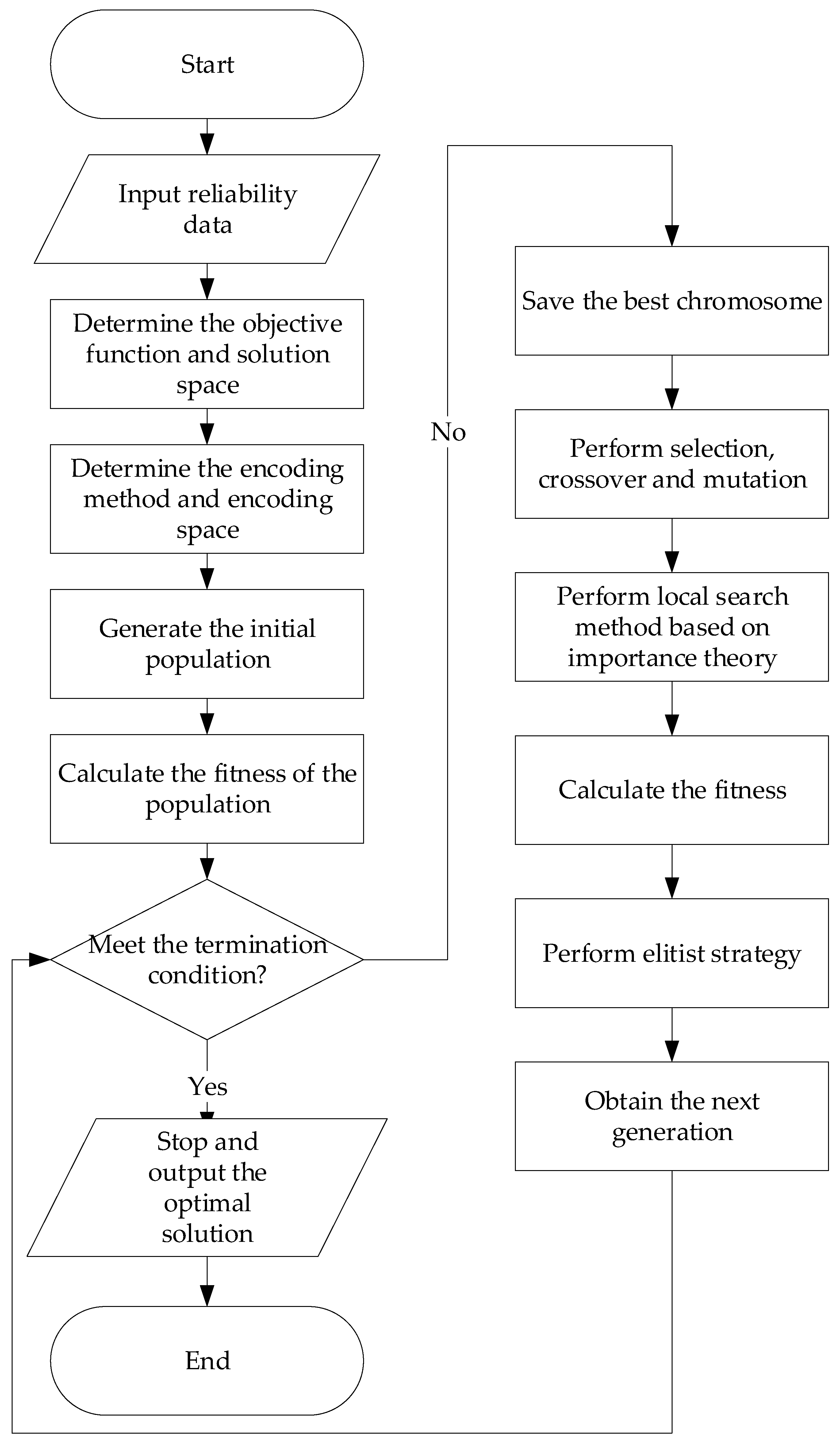
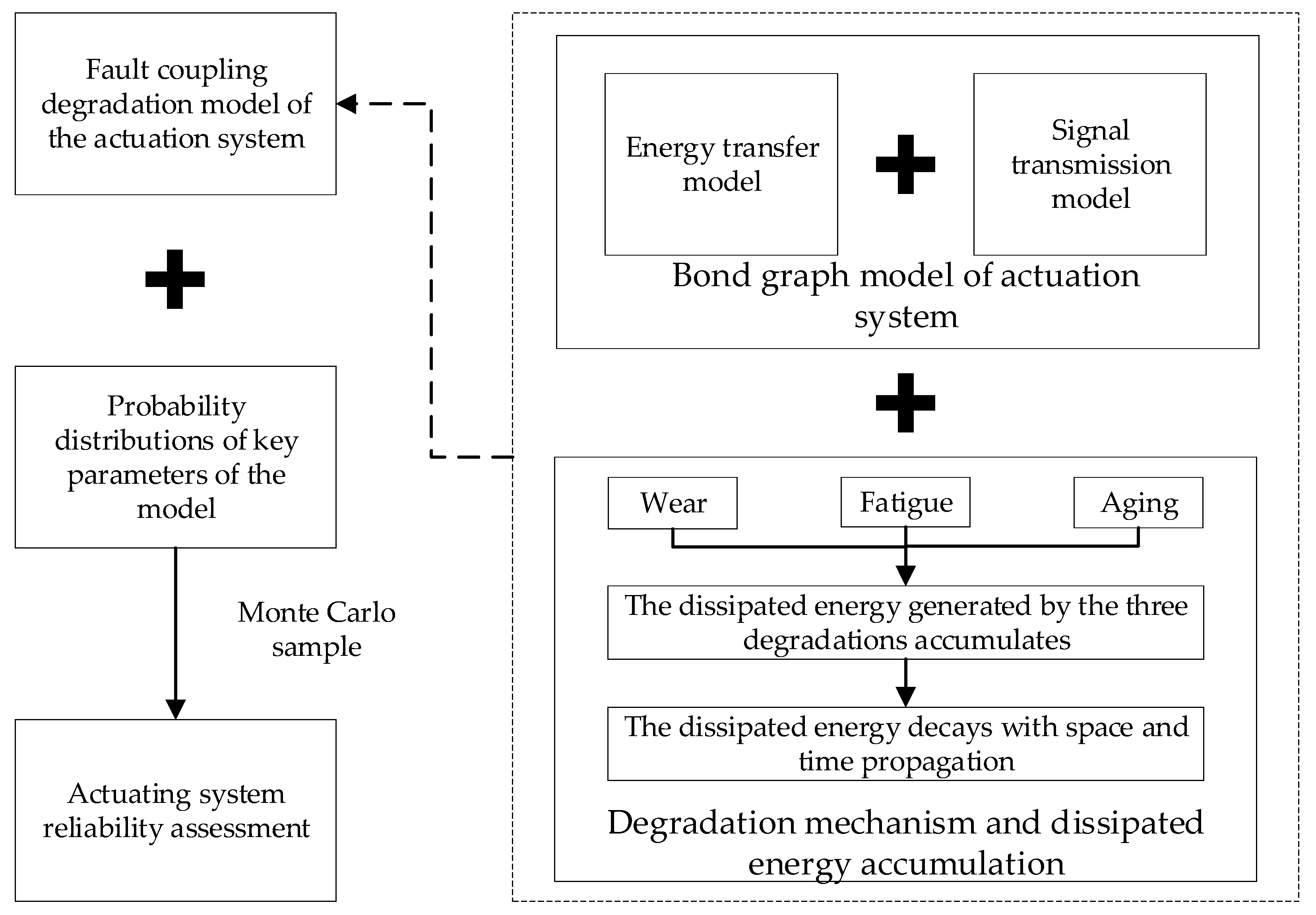

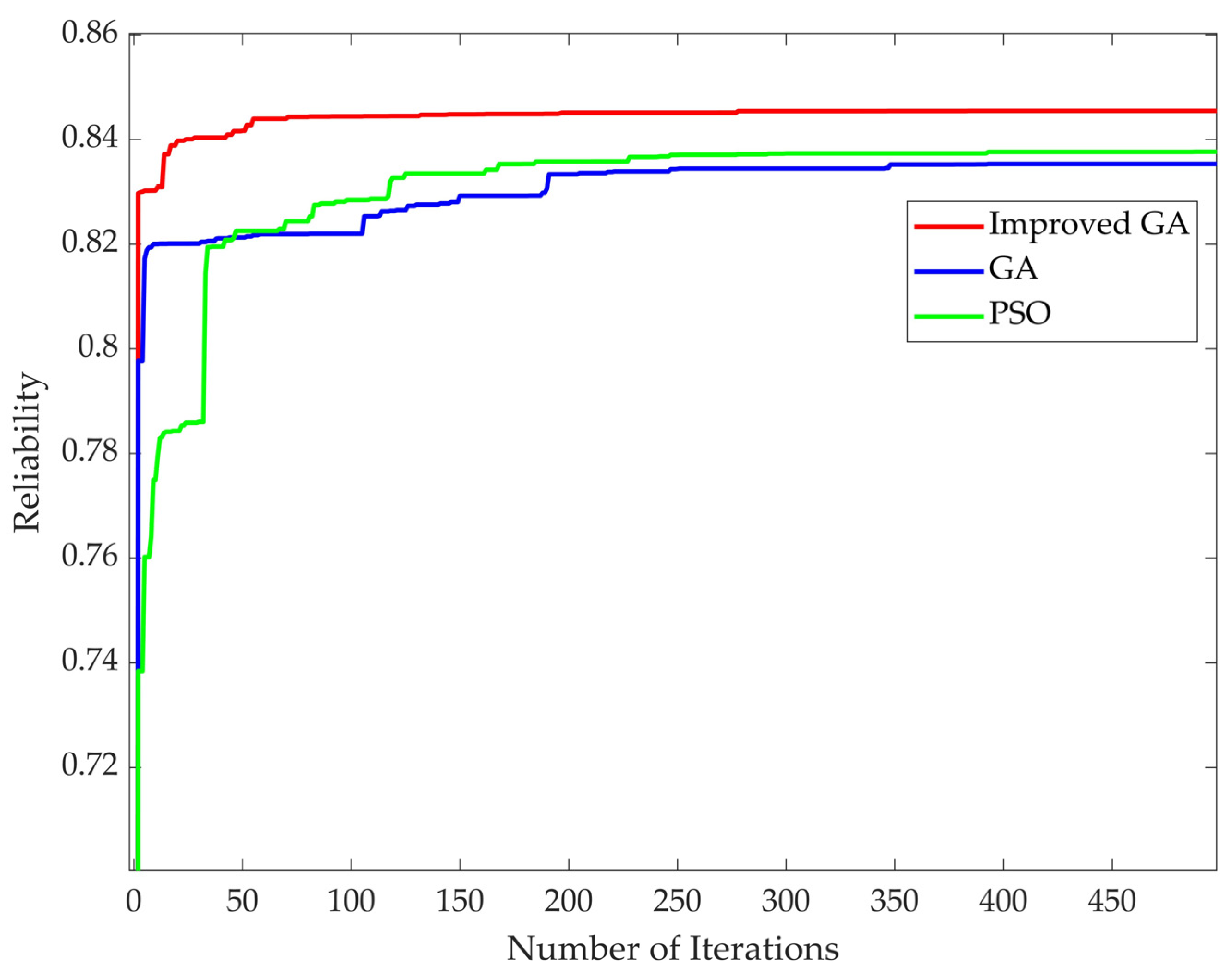
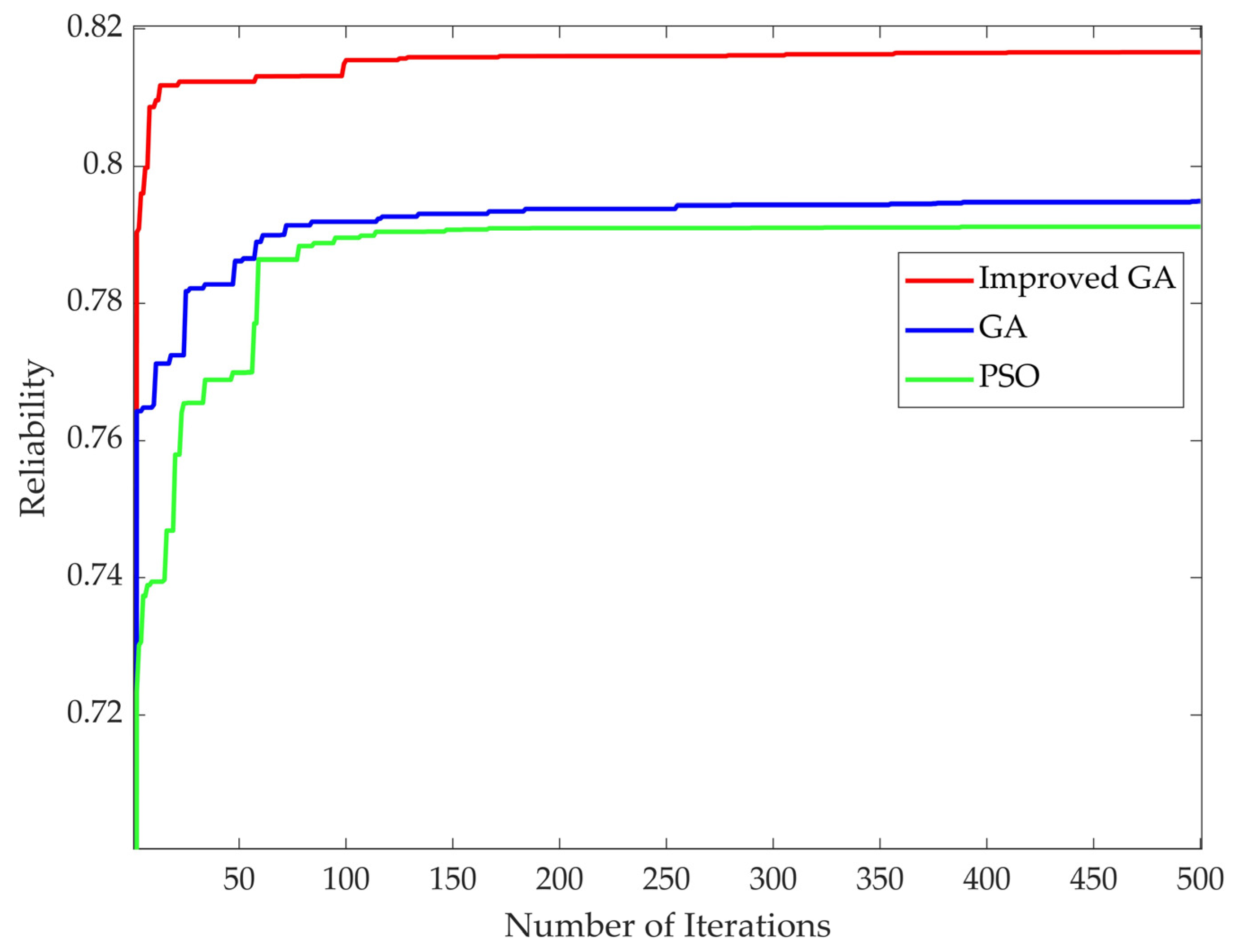
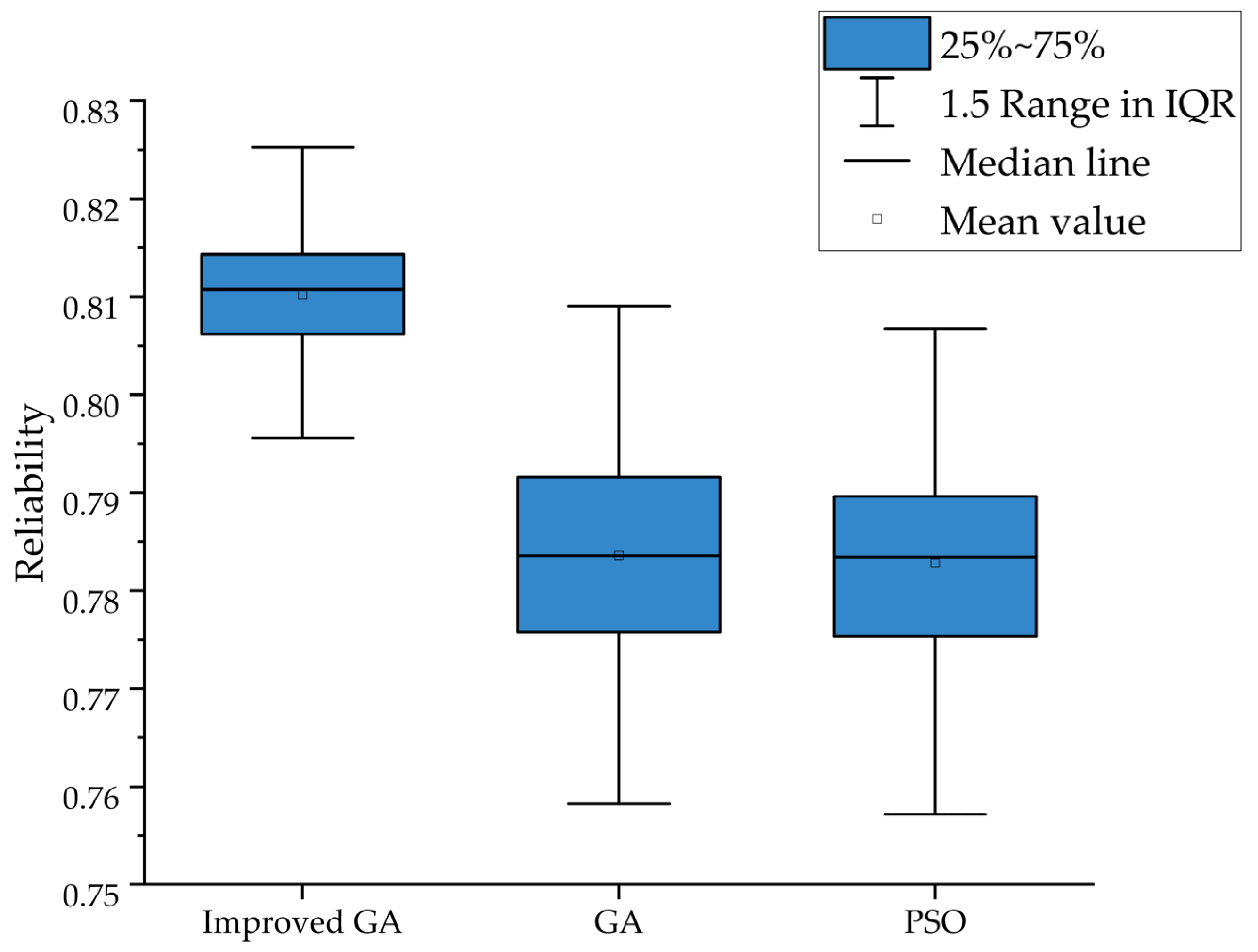
| Motor | Hydraulic Pump | Hydraulic Cylinder | Hydraulic Rod | |
|---|---|---|---|---|
| 0.98 | 0.97 | 0.98 | 0.97 | |
| 0.78 | 0.8 | 0.8 | 0.8 |
| Pump Source | HA Hydraulic Cylinder | Hydraulic Rod | HA | |
|---|---|---|---|---|
| 0.5 | 0.4 | 0.5 | — | |
| 0.75 | 0.72 | 0.89 | 0.48 | |
| 0.88 | 0.84 | 0.91 | — | |
| 0.98 | 0.97 | 0.97 | — | |
| 0.6 | 0.62 | 0.6 | — | |
| 3 | 5 | 3 | — |
| Motor | Hydraulic Pump | Hydraulic Cylinder | Hydraulic Rod | EHA | |
|---|---|---|---|---|---|
| 0.45 | 0.5 | 0.4 | 0.5 | — | |
| 0.85 | 0.81 | 0.75 | 0.89 | 0.459 | |
| 0.9 | 0.82 | 0.8 | 0.91 | — | |
| 0.98 | 0.98 | 0.97 | 0.97 | — | |
| 0.65 | 0.6 | 0.62 | 0.6 | — | |
| 4 | 3 | 5 | 3 | — |
| Algorithm | Pump Source | HA Hydraulic Cylinder | Hydraulic Rod | HA |
|---|---|---|---|---|
| Improved GA | 0.9422 | 0.9417 | 0.9542 | 0.846 |
| GA | 0.9559 | 0.9154 | 0.9562 | 0.834 |
| PSO | 0.9579 | 0.9124 | 0.9578 | 0.837 |
| Algorithm | Motor | Hydraulic Pump | Hydraulic Cylinder | Hydraulic Rod | EHA |
|---|---|---|---|---|---|
| Improved GA | 0.9521 | 0.9518 | 0.9466 | 0.9542 | 0.814 |
| GA | 0.9584 | 0.9514 | 0.9123 | 0.9562 | 0.794 |
| PSO | 0.9338 | 0.9589 | 0.9214 | 0.9578 | 0.789 |
Disclaimer/Publisher’s Note: The statements, opinions and data contained in all publications are solely those of the individual author(s) and contributor(s) and not of MDPI and/or the editor(s). MDPI and/or the editor(s) disclaim responsibility for any injury to people or property resulting from any ideas, methods, instructions or products referred to in the content. |
© 2024 by the authors. Licensee MDPI, Basel, Switzerland. This article is an open access article distributed under the terms and conditions of the Creative Commons Attribution (CC BY) license (https://creativecommons.org/licenses/by/4.0/).
Share and Cite
Cui, X.; Li, X.; Zhao, Z.; Yu, J.; Liu, D. Research on Classification Maintenance Strategy for More Electric Aircraft Actuation Systems Based on Importance Measure. Symmetry 2024, 16, 1127. https://doi.org/10.3390/sym16091127
Cui X, Li X, Zhao Z, Yu J, Liu D. Research on Classification Maintenance Strategy for More Electric Aircraft Actuation Systems Based on Importance Measure. Symmetry. 2024; 16(9):1127. https://doi.org/10.3390/sym16091127
Chicago/Turabian StyleCui, Xiaoyu, Xuanhao Li, Zhiyao Zhao, Jiabin Yu, and Di Liu. 2024. "Research on Classification Maintenance Strategy for More Electric Aircraft Actuation Systems Based on Importance Measure" Symmetry 16, no. 9: 1127. https://doi.org/10.3390/sym16091127
APA StyleCui, X., Li, X., Zhao, Z., Yu, J., & Liu, D. (2024). Research on Classification Maintenance Strategy for More Electric Aircraft Actuation Systems Based on Importance Measure. Symmetry, 16(9), 1127. https://doi.org/10.3390/sym16091127








